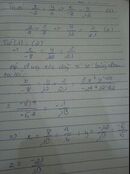Hãy nhập câu hỏi của bạn vào đây, nếu là tài khoản VIP, bạn sẽ được ưu tiên trả lời.

a) ĐK: x >= 0
<=> 7/2 + √x + 3/2 = 18
<=> 5 + √x = 18
<=> √x = 13
<=> x = 132 = 169 (nhận)
Vậy x = 169
b) ĐK: x >= 3
<=> √(x - 3) = 17
<=> x - 3 = 172 = 289
<=> x =292 (nhận)
Vậy x = 292

Giải:
a) \(\dfrac{1}{3}x+\dfrac{1}{5}-\dfrac{1}{2}x=1\dfrac{1}{4}\)
\(\Leftrightarrow\dfrac{1}{5}-\dfrac{1}{6}x=\dfrac{5}{4}\)
\(\Leftrightarrow\dfrac{1}{6}x=\dfrac{-21}{20}\)
\(\Leftrightarrow x=\dfrac{-63}{10}\)
Vậy ...
b) \(\dfrac{3}{2}\left(x+\dfrac{1}{2}\right)-\dfrac{1}{8}x=\dfrac{1}{4}\)
\(\Leftrightarrow\dfrac{3}{2}x+\dfrac{3}{4}-\dfrac{1}{8}x=\dfrac{1}{4}\)
\(\Leftrightarrow\dfrac{11}{8}x=\dfrac{-1}{2}\)
\(\Leftrightarrow x=\dfrac{-4}{11}\)
Vậy ...
Các câu sau làm tương tự câu b)

Bài 1:
a: \(\Leftrightarrow\dfrac{x+2}{2}=x-5\)
=>2x-10=x+2
=>x=12
b: \(\Leftrightarrow\left(x+2\right)^2=100\)
=>x+2=10 hoặc x+2=-10
=>x=-12 hoặc x=8
c: \(\Leftrightarrow\left(2x-5\right)^3=27\)
=>2x-5=3
=>2x=8
=>x=4

a. Áp dụng tính chất của dãy tỉ số bằng nhau ta có:
\(\dfrac{2x}{5}=\dfrac{y}{7}=\dfrac{y-2x}{7-5}=\dfrac{24}{2}=12\)
\(\Rightarrow2x=12\cdot5=60\Rightarrow x=60:2=30\)
\(y=12\cdot7=84\)
Vậy x = 30 ; y = 84
b. Áp dụng tính chất của dãy tỉ số bằng nhau ta có:
\(\dfrac{x}{3}=\dfrac{y}{2}=\dfrac{x+3y}{3+2\cdot3}=\dfrac{18}{9}=2\)
\(\Rightarrow x=2\cdot3=6\)
\(y=2\cdot2=4\)
Vậy x = 6 ; y = 4
c. Áp dụng tính chất của dãy tỉ số bằng nhau ta có:
\(\dfrac{x}{2}=\dfrac{y}{3}=\dfrac{z}{4}=\dfrac{x+y+z}{2+3+4}=\dfrac{18}{9}=2\)
\(\Rightarrow x=2\cdot2=4\)
\(y=3\cdot2=6\)
\(z=4\cdot2=8\)
Vậy x = 4 ; y = 6 ; z = 8
d. Áp dụng tính chất của dãy tỉ số bằng nhau ta có:
\(\dfrac{x}{2}=\dfrac{y}{3}=\dfrac{z}{4}=\dfrac{x-y-z}{2-3-4}=\dfrac{15}{-5}=-3\)
\(\Rightarrow x=-3\cdot2=-6\)
\(y=-3\cdot3=-9\)
\(z=-3\cdot4=-12\)
Vậy \(x=-4;y=-6;z=-8\)

Câu 2:
Áp dụng tính chất của dãy tỉ số bằng nhau, ta được:
\(\dfrac{x}{2}=\dfrac{y}{4}=\dfrac{z}{6}=\dfrac{x-y+z}{2-4+6}=\dfrac{8}{8}=1\)
Do đó: x=2; y=4; z=6

Bài 1:
\(a,\dfrac{x}{3}=\dfrac{y}{7}\) và \(x+y=20\)
\(=\dfrac{x+y}{3+7}=\dfrac{20}{10}=2\)
\(\Rightarrow x=2.3=6\)
\(y=2.7=14\)
Vậy \(x=6\) và \(y=14\)
\(b,\dfrac{x}{5}=\dfrac{y}{2}\) và \(x-y=6\)
\(=\dfrac{x-y}{5-2}=\dfrac{6}{3}=2\)
\(\Rightarrow x=2.5=10\)
\(y=2.2=4\)
Vậy \(x=10\) và \(y=4\)
\(c,\dfrac{x}{7}=\dfrac{18}{14}\)
Từ tỉ lệ thức trên ta có:
\(14x=7.18\)
\(x=\dfrac{7.18}{14}\)
\(x=9\)
Vậy \(x=9\)
\(d,6:x=1\dfrac{3}{4}:5\)
\(6:x=\dfrac{7}{20}\)
\(x=6:\dfrac{7}{20}\)
\(x=\dfrac{120}{7}\)
Vậy \(x=\dfrac{120}{7}\)
\(e,\dfrac{x}{2}=\dfrac{y}{4}=\dfrac{z}{6}\) và \(x-y+z=8\)
\(=\dfrac{x-y+z}{2-4+6}=\dfrac{8}{4}=2\)
\(\Rightarrow x=2.2=4\)
\(y=2.4=8\)
\(z=2.6=12\)
Vậy \(x=4;y=8;z=12\)
a, \(\dfrac{x}{3}=\dfrac{y}{7}=\dfrac{x+y}{3+7}=\dfrac{1}{2}\)
Từ đó suy ra x=1,5; y=3,5
b,\(\dfrac{x}{5}=\dfrac{y}{2}=\dfrac{x-y}{5-2}=\dfrac{1}{2}\)
Từ đó suy ra x=2,5; y=1
c,\(\dfrac{x}{7}=\dfrac{18}{14}\Leftrightarrow\dfrac{x}{7}=\dfrac{9}{7}\Rightarrow x=9\)
d,\(\dfrac{6}{x}=\dfrac{\dfrac{7}{4}}{5}\Leftrightarrow\dfrac{6}{x}=\dfrac{24}{7}\left(\dfrac{\dfrac{7}{4}}{5}\right)\Leftrightarrow\dfrac{6}{x}=\dfrac{6}{\dfrac{120}{7}}\Rightarrow x=\dfrac{120}{7}\)
e,\(\dfrac{x}{2}=\dfrac{y}{4}=\dfrac{z}{8}=\dfrac{x-y+z}{2-4+8}=\dfrac{4}{3}\)
Từ đó suy ra x=\(\dfrac{8}{3}\); y=\(\dfrac{16}{3}\); z=\(\dfrac{32}{3}\)

Lời giải :
Theo đề bài ta có \(\frac{x}{\frac{5}{2}}=\frac{y}{\frac{4}{3}}=\frac{z}{\frac{6}{5}}\Leftrightarrow\frac{2x}{5}=\frac{3y}{4}=\frac{5z}{6}\)
Đặt \(\frac{2x}{5}=\frac{3y}{4}=\frac{5z}{6}=k\)
\(\Leftrightarrow\hept{\begin{cases}x=\frac{5k}{2}\\z=\frac{6k}{5}\end{cases}}\)
Mặt khác : \(\frac{x}{2}=\frac{z-28}{3}\)
\(\Leftrightarrow3x-2z=-56\)
\(\Leftrightarrow3\cdot\frac{5k}{2}-2\cdot\frac{6k}{5}=-56\)
\(\Leftrightarrow k=\frac{-560}{51}\)
\(\Leftrightarrow\hept{\begin{cases}x=\frac{-1400}{51}\\y=\frac{-2240}{153}\\z=\frac{-224}{17}\end{cases}}\)
\(B=x+y-z=\frac{-1400}{51}+\frac{-2240}{153}-\frac{-224}{17}=\frac{-4424}{153}\)

Áp dụng tính chất của dãy tỉ số bằng nhau, ta được:
\(\dfrac{x}{4}=\dfrac{y}{5}=\dfrac{x+y}{4+5}=\dfrac{18}{9}=2\)
Do đó: x=8; y=10